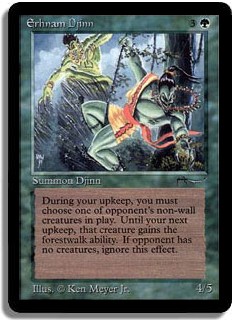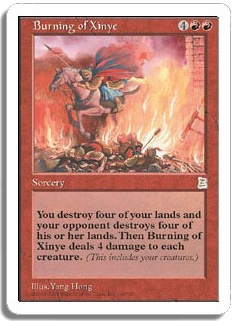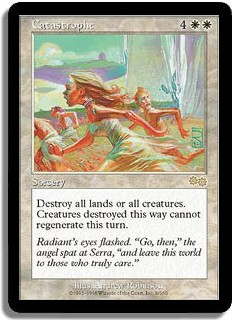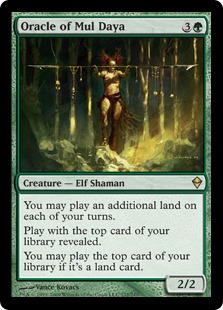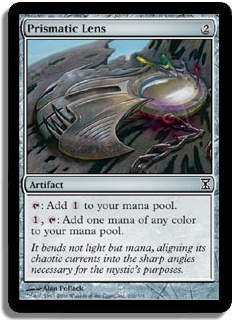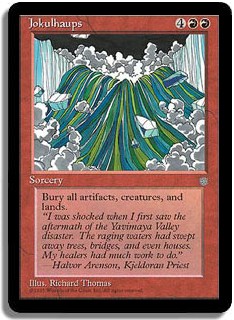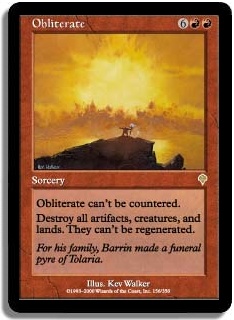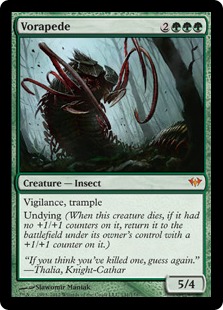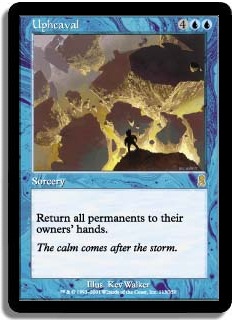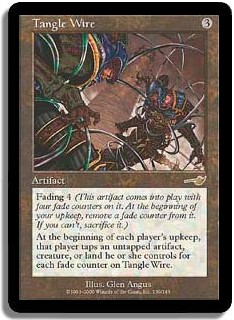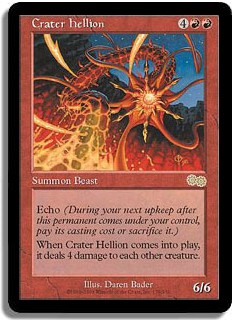In a previous article about enablers, I talked about several cards used to help enable Reanimation archetypes in your cube while being generally useful in other archetypes. In this article, I’ll discuss another archetype: decks based on symmetrical disruption and some ideas on cards that can be used to enable those strategies.
One of the decks that I remember most from the early days of Magic’s history is the "Erhnam-Geddon" deck; a deck that would use mana acceleration to cast a quick Erhnam Djinn and cast an Armageddon to not only deal with the drawback on Erhnam Djinn, but to disrupt the opponent. Since you had a 4/5 out, you’d be able to end the game quickly.
Decks based on symmetrical disruption in cube don’t have to resort to using creatures like Erhnam Djinn (I mean, compare that to Yeva, Nature’s Herald from Magic 2013; how far we’ve come!) whose drawbacks are negated by symmetrical disruption. Many cube decks use a similar strategy to win: get a big threat onto the battlefield and disrupt the opponent’s resources to deal with your threat to win the game. Â
The nice thing about this archetype is that unlike something like Reanimator, a lot of cubes already support the archetype pretty well. Cubes already have a good amount of big finishers and cards that work synergistically well with cards in the deck; getting a Sword with protection from red (combined with a card like Wildfire or Burning of Xinye) on either a huge finisher or a mana elf is great, and cards that work well with mass-creature destruction spells like Wurmcoil Engine and Vorapede have been making marks in peoples’ cubes for some time. However, we can still take steps to improve this archetype in cube.
One of the most recognized and successful decks in cube that effectively utilizes symmetrical disruption is the Wildfire deck. You use acceleration to power out a big creature like an Inferno Titan and then disrupt your opponent with the namesake spell, winning shortly after. Despite seeing Destructive Force in Magic 2011, the advent of planeswalkers and the increased popularity of Commander (and that format’s general disdain of mass-land destruction) will probably inhibit the printing of another truly efficient mass-land destruction effect for quite some time.
Most cubes already have an existing strong core of cards to support this archetype like Wildfire and Burning of Xinye along with other symmetrical disruption spells like Armageddon, Ravages of War, and Catastrophe. However, there are some other cards that cube designers can use to further support those archetypes. The first are some of the less-loved symmetrical-disruption effects; these include ones like Death Cloud, Pox, Tectonic Break, Jokulhaups, Obliterate, Devastation (oh how I wish this cost six mana!), and Destructive Force.
Each of these works in different ways, but the result is similar: all of these spells seek to destroy an opponent’s resources so that they can’t deal with whatever you cast beforehand. Many of these aren’t used much because they’re expensive in mana cost (especially Devastation and Destructive Force). It’s also worth noting that ones like Death Cloud and Jokulhaups can be harder to "break" than ones like Wildfire, since the game plan is usually carried out by casting a huge creature and riding it to victory and if all creatures are destroyed, usually it’s just planeswalkers that stick around (although a planeswalker, especially one like Chandra Nalaar, Jace, the Mind Sculptor, or Karn Liberated can be just insane after a Jokulhaups).
It’s important to keep all of these cards in mind. Even though they’re not as strong as ones like Wildfire and Burning of Xinye, they work similarly to those cards by allowing you to disrupt your opponent after a big threat is in play. In the case of planeswalkers like Karn Liberated or Nicol Bolas, Planeswalker, those cards can act as both disruption and threat.
A very important piece of symmetrical disruption decks are acceleration cards. Acceleration is very useful in symmetrical disruption decks. Creature-based acceleration is definitely useful as it helps you accelerate into your big spells and finishers, but they can be awkward and a nombo with spells like Wildfire and Wrath of God. (Although ones like Oracle of Mul Daya are pretty solid in these decks as, by the time it dies from a symmetrical disruption spell, it’ll get some lands to make sure its legacy lives on.) However, mana rocks like Prismatic Lens and Everflowing Chalice are extremely useful in these decks as they usually survive through spells like Death Cloud, Balance, and Burning of Xinye.
It’s also important to note that cards that work well with mana rocks like Tezzeret, Agent of Bolas, Tolarian Academy, and Tinker work exceptionally well in symmetrical decks, as those are all synergistic with all of those cards. Much like how cards like Thirst for Knowledge and Frantic Search are generally solid cards that enable Reanimator but are good in blue decks in general, all of the mana rocks like those mentioned, Thran Dynamo, and Gilded Lotus are just solid ramp spells in non-aggressive decks that seek to go into the late game. They work exceptionally well with cards like Death Cloud, Balance, and Wildfire.
To reference the earlier discussion about cards like Jokulhaups and Obliterate, it’s important to note that these spells don’t tend to work well with mana rocks as those spells destroy artifacts. This is why Jokulhaups and Obliterate can be awkward in the Wildfire deck, since those types of decks usually use artifacts that produce mana to have a better board state than their opponent. Granted, while Jokulhaups and Obliterate don’t work as well with mana rocks, they work extremely well with cards that give permanent-based benefits after they die like Wurmcoil Engine, Thragtusk, and Vorapede. (It’s one thing to gain five life from Kokusho, the Evening Star once it dies after a Jokulhaups, it’s another to have a 6/5 undead trampling vigilant Insect on an empty board!)Â
Even having something like a 1/1 persisted Murderous Redcap or a Glen Elendra Archmage is very nice to have as well, and taking that into account is important when looking at how good symmetrical-disruption decks are in your cube and other cubes. One thing that I noticed when drafting the Magic Online Cube was that it had Wildfire, Burning of Xinye, and Destructive Force (and while I obviously disagree with them cutting Signets and talisman cards out of their cube, I don’t see that changing anytime soon). Due to having support through cards like Everflowing Chalice, those decks came up every once in a while since cards like that were useful cards in all kinds of decks.
It’s also worth mentioning Upheaval, a card that I found people were underrating a lot in the early days of the Magic Online Cube but learned how to utilize. Upheaval works really well with symmetrical-removal spells like Wildfire since the cards are best used in the same way—get a lot of mana out, cast something, and win after the disruption. Granted, Upheaval is the absolute best in the business at letting you come out ahead after casting it, but it’s also important to note that symmetric-disruption cards work very well with Upheaval as well, so you can take advantage of those synergies.
There are cards that work well in other archetypes that work fine when combined with symmetrical-disruption. One of these types is cards that Blink other cards. Cards like Flickerwisp work really well with symmetrical-disruption by letting you "hide" key permanents from those spells; Flickerwisping even a Signet so that it sticks around post-Death Cloud is a really useful effect and having a Venser, the Sojourner with any of these effects is just absurd, since your opponent likely can’t stop Venser from reaching emblem mode. (Also, it’s important to note that recent Blink cards like Cloudshift and Restoration Angel are a nombo with cards like Death Cloud and Wildfire. Be sure to keep this in mind when evaluating these archetypes!)Â
Green land acceleration decks, especially decks that go all-in on that strategy, also work very well with cards like Death Cloud and Wildfire since they let you have a lot of lands to both power out a big Death Cloud and let you have enough lands to end up ahead in the land race after those spells resolve. Other cards like Armageddon and Tangle Wire, both of which are mainly used in aggressive decks, can be effectively used to cause stalls so you can break the symmetry.
Tangle Wire is one of the more notorious examples (opponent taps four permanents after you cast it, you tap three, one of which is Tangle Wire), and it can be used as symmetrical disruption. Smokestack has also been used for years as a way to break symmetries (through soot counter manipulation, token generators, etc.), and Smokestack also helps to provide disruption for symmetrical-disruption decks (especially if you’ve destroyed their lands through land destruction effects.)Â
Other cards that have been used effectively in unconventional ways are cards like Bloodghast that take advantage of symmetrical discard. Think back to Reid Duke Legacy Pox deck from earlier this year; although cubes don’t typically use Nether Spirit (nor do I recommend it due to very limited use), Bloodghast works by helping to break the symmetrical effects imposed by both Pox and Smallpox. It can be harder for you to show your drafters these interactions when you’re designing a cube, but it’s important to look for these unconventional uses when drafting.
While having artifacts that create mana after a symmetrical-disruption spell resolves is a good thing, Â make sure that decks that utilize symmetrical disruption can deal with opposing artifacts/enchantments (or other mana bugs); Wickerbough Elder and Indrik Stomphowler are very useful. Much like generally good creatures and like Wurmcoil Engine and Reveillark that don’t necessarily require being built around, they’re both useful cards in cube that can help cripple an opponent who is reliant on using mana rocks post-mass disruption.
You should also include "multitaskers"—cards that perform more than one task in the deck and also supplement themes that are in your deck (as discussed earlier.) Cards like Elesh Norn, Grand Cenobite have been great in my cube and for many years. I ran Crater Hellion as a way to help improve red control decks and Wildfire decks as a creature that supplemented Wildfire and Burning Xinye by acting in a similar role (at least on the dealing four damage to all creatures) while providing a 6/6 body (albeit with echo.)
It was very useful because, while there are a lot of creatures that destroy a single creature, there aren’t many that destroy several and outside of ones like Elesh Norn, Grand Cenobite, Inferno Titan, and Massacre Wurm, a majority of them just aren’t that great (Sunblast Angel isn’t used in many cubes.) I ended up cutting it due to space constraints, but that by no means implies that I thought it was bad, as I very well may add it back if I want more support for the Wildfire/mass-removal deck. It’s important to keep these tools in your on-deck box so that you can have them tools ready if you want to strengthen these archetypes.
I hope that this article has given you some valuable insight on how to use cards that can break symmetries and allow you to gain huge advantages over opponents. These cards have been powerful cards that people have been building around since the game began, and I hope that you have gained some knowledge on how to encourage these decks to flourish in your cube.
May all of your opening packs contain Sol Rings!
@UsmanTheRad on Twitter
http://idratherbecubing.wordpress.com – my blog featuring my cube lists.
The Third Power: A Cube podcast featuring myself and Anthony Avitollo!

